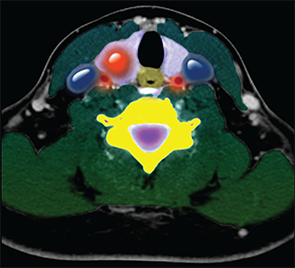
Color-enhanced cross sectional CT image of the neck showing a nodule (large round red density) in the right lobe of the thyroid gland (purple).
Living Art Enterprises, LLC / Science Source
Thyroid nodules are extremely common; some studies using high-resolution ultrasound show that up to 70% of the population have thyroid nodules, with a generally higher prevalence in women and the elderly, said Mark Zafereo, MD, a head and neck surgeon at the University of Texas MD Anderson Cancer Center in Houston.
Explore This Issue
June 2016To assist physicians who are recommending appropriate diagnosis and treatment options, the American Thyroid Association (ATA) released the third iteration of its thyroid nodule and thyroid cancer guidelines in late 2015. The “2015 American Thyroid Association Management Guidelines for Adult Patients with Thyroid Nodules and Differentiated Thyroid Cancer” are now available from the journal Thyroid (2016;26:1-133).
The guidelines contain 101 separate recommendations for best practices that include diagnosing and managing patients with thyroid nodules and differentiated thyroid cancer, interpreting biopsy results and molecular marker studies, initiating risk assessment and cancer screening, and initiating and monitoring various therapies. Recommendations are rated from strong to weak based on the quality of the evidence available for each.
“There are more options for recommendations now, so you must have the rationale and substantiation for each of those options,” said Ralph P. Tufano, MD, MBA, the Charles W. Cummings MD Professor and director of the division of head and neck endocrine surgery in the department of otolaryngology-head and neck surgery at Johns Hopkins University School of Medicine in Baltimore.
Dr. Zafereo believes that the timing of the update is ideal. “Thyroid cancer incidence in the United States, particularly well-differentiated thyroid cancer, has nearly doubled since the last ATA guidelines were published in 2009,” he said. “Studies have predicted that thyroid cancer may be the third most common cancer diagnosed among women by 2020, with economic impact of $20 billion. Much of this increase is attributable to increased incidental diagnosis of thyroid nodules and cancer on imaging and pathology.”
The Recommendations
Revised guidelines for thyroid nodule management include recommendations on:
- Initial evaluation;
- Clinical and ultrasound criteria for fine-needle aspiration biopsy;
- Interpretation of fine needle aspiration biopsy results;
- Use of molecular markers; and
- Management of benign thyroid nodules.
Revised guidelines for initial thyroid cancer management include recommendations on:
- Screening for thyroid cancer;
- Staging and risk assessment;
- Surgical management;
- Radioiodine remnant ablation and therapy; and
- Thyrotropin suppression therapy using levothyroxine.
Revised guidelines for long-term differentiated thyroid cancer management include recommendations on:
- Surveillance for recurrent disease using imaging and serum thyroglobulin;
- Thyroid hormone therapy;
- Management of recurrent and metastatic disease; and
- Consideration for clinical trials and targeted therapy.
In creating the new version, the guideline panel had complete editorial independence from the ATA. The specific clinical questions addressed in the guidelines were based on prior versions of the guidelines, stakeholder input, and input from task force members; published English-language articles on adult patients were eligible for inclusion.